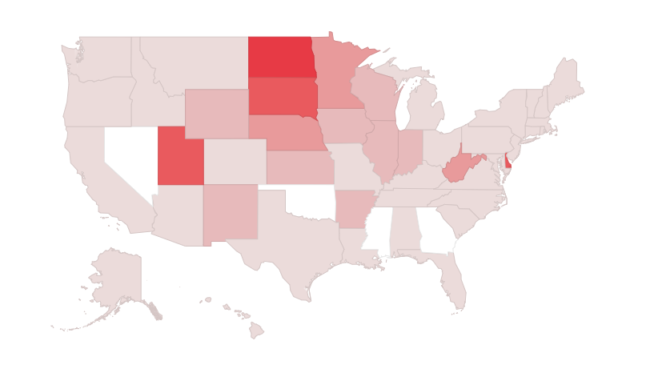States that permit recreational marijuana sales have significantly lower rates of vaping-related lung injuries, according to a new study published in JAMA Network Open. After performing a state-level, cross-sectional analysis, the authors concluded: “A test of the difference in mean case rates implies that recreational marijuana states have 7.1 fewer cases per million than medical marijuana states and 6.4 fewer cases per million than prohibition states.”
Last December, Jeffrey Miron and I published our own state-level, cross-sectional analysis in Reason that similarly concluded: “Overall, states with legalized marijuana have reported approximately 6.7 fewer lung injuries per million people than states that have not yet permitted recreational cannabis sales, according to our analysis of CDC data.”
Vaping-Related Illnesses Per Million People
(Click a state for more information)
[show-map id=’38’]
Similar to the JAMA authors, we chose to compare states that permitted recreational marijuana sales to all other states, even if they regulated a medical marijuana market without a recreational market. We did this because we hypothesized that vaping-related injuries were almost always caused by products purchased in illicit markets and that only permitting a medical marijuana market would not provide sufficient access for most recreational marijuana users to obtain safe products. The JAMA authors’ analysis agrees with our sentiment, commenting, “The difference in the EVALI case rate between medical and prohibition states was not statistically significant.” And with our estimate right between both of the authors’ estimates, it looks like our results match perfectly.
Based on these results, it can be said that marijuana prohibition was a major factor in causing the vaping-related lung-injury “epidemic.” According to both analyses, if every state permitted a recreational marijuana market, there would have been approximately 1,663 fewer vaping-related lung injuries — a 62 percent decrease from approximately 2,667 total recorded injuries in 2019.
While considering these estimates, it’s important to remember that marijuana is still technically illegal in every state due to federal law. As of now, 11 states and Washington, D.C. have voted to “legalize” marijuana, but since the federal government’s Schedule I (total prohibition) designation supersedes all state laws, current “legalization” should just be interpreted as supplier decriminalization. This means that if the federal government legalized marijuana, we would expect even fewer vaping-related lung injuries than the studies estimate.
After months of suggesting legal vaping products could be to blame for vaping illnesses in 2019, the Centers for Disease Control and Prevention (CDC) did not concede that the lung injuries were disproportionately caused by “tetrahydrocannabinol (THC)-containing products primarily from informal sources” until January 2020. In contrast, organizations that looked closely at the data, like the Competitive Enterprise Institute, Reason Foundation, and the Cato Institute, pointed out that the illicit market was the culprit as early as July 2019.
With federal bureaucracies like the CDC and Food and Drug Administration (FDA) slow to make this distinction, the public was confused as the agencies waged a war against legal nicotine e-cigarettes, which have not been shown to be the cause of a single recorded vaping-related lung injury. And during the current coronavirus pandemic, it’s important for agencies at all levels to allow marijuana businesses and tobacco shops to operate so that illicit manufacturers don’t replace the regulated suppliers.
As Reason’s Jacob Sullum points out, as the ongoing COVID-19 pandemic is devastating hospitals and economies across the globe, it’s high time for public health agencies to prioritize their original purpose — preventing actual epidemics — as opposed to metaphorical “epidemics” of self-endangering behavior. Especially when the government’s prohibition is a significant cause of the problem in the first place.

